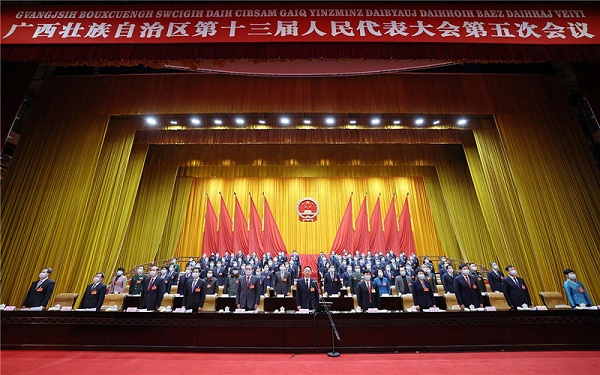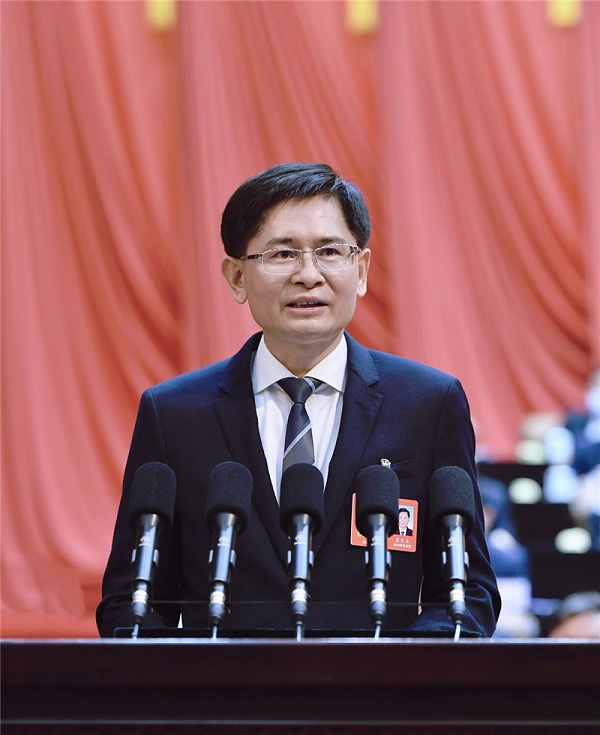GDP of Guangxi predicted to climb 6.5% in 2022

The fifth session of the 13th Guangxi Zhuang Autonomous Regional People's Congress opens on Jan 17 in Nanning. [Photo by Huang Ke and Tang Diansheng/gxzf.gov.cn]
Guangxi Zhuang autonomous region has gotten off to a good start in the 14th Five-Year Plan (2021-25) period with an eye-catching performance in 2021, officials announced at the fifth session of the 13th Guangxi Zhuang Autonomous Regional People's Congress, which opened on Jan 17 in Nanning.
The region's GDP is projected to achieve a year-on-year growth of 7.5 percent in 2021, making the two-year average growth 5.6 percent. Its industrial added value above designated size, total retail sales of consumer goods, as well as import and export trade volume in 2021 increased by 8.6 percent, 9 percent, and 22.2 percent respectively, while its general public budget revenue increased by 4.8 percent.
Lan Tianli, chairman of Guangxi Zhuang autonomous region, noted that the annual target for the region's GDP growth in 2022 is 6.5 percent in the 2022 government work report.

Lan Tianli, chairman of Guangxi Zhuang autonomous region, delivers the 2022 government work report. [Photo by Deng Hua/gxzf.gov.cn]
Targets for other economic indexes were also set. Guangxi will strive to achieve 3 percent growth in its general public budget revenue, 10 percent growth in fixed-asset investments, 8 percent growth in total retail sales of consumer goods, 7 percent growth in industrial added value above designated size, as well as 7 percent growth in import and export trade volume.
Ten major goals have been outlined for the year, among them are:
Guangxi will further its rural revitalization efforts in a comprehensive manner. A total of 2.5 million mu (166,667 hectares) new high-standard farmland will be built, while demonstration zones on modern distinctive agriculture, forestry, aquaculture, and ecological breeding will also be constructed. Brands for local products like Liubao tea, jasmine flower, citrus, passion fruit, and mango will be further promoted.
More support will be given to counties that have been recently lifted out of poverty to build modern distinctive agricultural demonstration zones.
All villages will have 4G network coverage and renovations for old residential communities in border areas will be carried out.
An underground pipeline network of 3,500 kilometers will be built or renovated to achieve a central collection rate of urban sanitary sewage of over 50 percent. A total of 120,000 old residential communities in downtown areas will be renovated and more elevators will be installed in existing buildings.
In terms of industrial revitalization, Guangxi will allocate 40 billion yuan ($6 billion) in financial funds and special government bonds to promote project construction, striving to achieve an industrial investment growth of over 20 percent.
Twenty companies at the 10-billion-yuan level, 170 industry leading enterprises, and 30 single champion companies at the autonomous region level will be cultivated. It will also strive to have three industrial parks at the 100-billion-yuan level, four at the 50-billion-yuan level, and 44 at the 10-billion-yuan level.
Guangxi will launch over 110 major sci-tech innovation projects, 70 with breakthroughs in major technologies, and over 750 featuring transformation of sci-tech outcomes.
It will add 500 hi-tech companies, 100 specialized, elaborative, characteristic, and innovative enterprises at the autonomous regional level, as well as 30 gazelle companies and three technology innovation centers.
Thirty demonstration pilots for the deep integration and application of artificial intelligence and the real economy will be established, along with more than 60 demonstrative smart companies and over 60 digitalization workshops.
Guilin will be further built as a world-class tourism city and Guangxi will strive to become a world-famous tourism hot spot. Construction of a distinctive tourism belt alongside the China-Vietnam border and the Bama Longevity Health International Tourism Zone will be pushed forward. A national tourism sightseeing rim around Guangxi will also be formed.
The Beibu Gulf International Gateway Port will open 10 new foreign trade shipping routes, achieve an annual container throughput of 7 million twenty-foot equivalent units (TEUs), and operate more than 7,000 sea-rail intermodal trains on the New International Land-Sea Trade Corridor.
